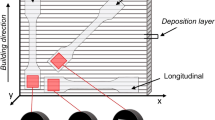Abstract—The bending-deformation behavior of rapidly quenched Co69Fe4Cr4Si12B11 alloy wires 0.1–1 mm in diameter, which are fabricated by the Ulitovskii–Taylor method, are studied. A correlation between the failure mechanism of a wire and its diameter and bending loading conditions is shown. It is found that wires up to 0.2 mm in diameter exhibit no bending failure. The wedge-type fracture is observed for wires 0.2–0.35 mm in diameter; wires more that 0.35 mm in diameter exhibit steplike fracture. The wedge-type fracture, a dense regular shear-band network, and vein- and corallike fracture are shown to correspond to the 100% amorphous state of wires. This combination of signs is observed for wires up to 0.4 mm in diameter.








Similar content being viewed by others
REFERENCES
V. V. Molokanov, T. R. Chueva, P. P. Umnov, E. E. Shalygina, and S. V. Simakov, “Thick amorphous wires of the Fe75Si10B15–Co75Si10B15–Ni75Si10B15 system: fabrication, structure, and properties,” Perspektiv. Mater., No. 2, 5–11 (2016).
F. Qin and H.-X. Peng, “Ferromagnetic microwires enabled multifunctional composite materials,” Prog. Mater. Sci. 58, 183–259 (2013).
V. S. Larin, A. V. Torcunov, A. Zhukov, J. González, M. Vazquez, and L. Panina, “Preparation and properties of glass-coated microwires,” J. Mag. Mag. Mater. 249 (1–2), 39–45 (2002).
P. P. Umnov, V. V. Molokanov, Yu. S. Shalimov, N. V. Umnova, T. R. Chueva, and V. T. Zabolotnyi, “Manufacturing peculiarities of amorphous wire by the Ulitovskii–Taylor method using continuous casting,” Perspektiv. Mater., No. 2, 87–91 (2010).
P. P. Umnov, D. M. Panferov, T. R. Chueva, N. V. Umnova, K. S. Filippov, and V. V. Molokanov, “Effect of precursor melting method on the structure and properties of a “thick” Co-alloy amorphous microwire,” Perspektiv. Mater., No. 7, 61–67 (2016).
T. R. Chueva, V. V. Molokanov, P. P. Umnov, and N. V. Umnova, “Application of thermal analysis in developing the preparation technology of melt for the fabrication of “thick” Co-alloy amorphous microwire,” Fiz. Khim. Obtab. Mater, No. 6, 82–89 (2016).
P. P. Umnov, V. V. Molokanov, N. V. Kurakova, A. N. Shalygin, V. N. Grishin, A. G. Kolmakov, and Yu. K. Kovneristyii, “Defects and their effect on physico-mechanical properties of composite microwire amorphous metallic core–glass sheath,” Deform. Razrushenie Mater., No. 10, 40–46 (2007).
A. V. Sergueeva, J. Walleser, J. Zhou, B. E. Meacham, and D. J. Branagan, “Ductile high strength microwires from glassy nanosteel alloys,” Mater. Sci. Eng. A 534, 603–608 (2012).
Y. Shi, J. Luo, F. Yuan, and L. Huang, “Intrinsic ductility of glassy solid,” J. Appl. Phys. 115 (4), 043528 (1–17) (2014).
A. Inoue, M. Hagiwara, and T. Masumoto, “Mechanical properties of Fe–Si–B amorphous wires produced by in-rotating-water spinning method,” J. Metall. Mater. Trans. A 13 (3), 373–382 (1982).
B. A. Sun and W. H. Wang, “The fracture of bulk metallic glasses,” Prog. Mater. Sci. 74, 211–307 (2015).
J. A. Verduzco, R. J. Hand, and H. A. Davies, “A comparison of the mechanical properties of Fe–Cr–Si–B metallic glass wires and HT steel wires,” in Proceedings of 13th European Conference on Fracture (San Sebastián, 2000).
H. Lavvafi, J. R. Lewandowski, and J. J. Lewandowski, “Flex bending fatigue testing of wires, foils, and ribbons,” Mater. Sci. Eng. A 601, 123–130 (2014).
V. V. Molokanov, P. P. Umnov, N. V. Kurakova, M. A. Sevost’yanov, A. G. Kolmakov, A. N. Shalygin, and Yu. K. Kovneristyii, “Optimization of preparation technology of composite material: high-strength steel wire–amorphous surface soft-magnetic Co-alloy layer,” Perspektiv. Mater., No. 4, 93–100 (2006).
P. P. Umnov, N. V. Umnova, A. A. Stegnukhin, A. V. Lavrenyuk, V. V. Samsonova, and V. V. Molokanov, “Effect of quenching conditions on the structure and properties of “thick” wire fabricated by Ulitovskii–Taylor method,” Deform. Razrushenie Mater., No. 11, 11–14 (2012).
I. I. Mokhirev, T. P. Chueva, V. T. Zabolotntii, P. P. Umnov, N. V. Umnova, and V. V. Molokanov, “Strength and plastic properties of long Co-alloy amorphous wires prepared by various rapid melt-quenching techniques,” Deform. Razrushenie Mater., No. 7, 31–35 (2010).
S. F. Guo, K. C. Chan, and L. Liu, “Notch toughness of Fe-based bulk metallic glass and composites,” J. Alloys Compd. 509 (39), 9441–9446 (2011).
J. A. Verduzo, “Fatigue fracture morphologies of some Fe-based amorphous alloy wire,” Mater. Lett. 57 (5), 1029–1033 (2003).
ACKNOWLEDGMENTS
This study was performed in terms of state task no. 007-00129-18-00.
Author information
Authors and Affiliations
Corresponding author
Additional information
Translated by N. Kolchugina
Rights and permissions
About this article
Cite this article
Molokanov, V.V., Chueva, T.R., Umnova, N.V. et al. Bending Failure of “Thick” Co-Based-Alloy Amorphous Wires. Russ. Metall. 2019, 409–414 (2019). https://doi.org/10.1134/S0036029519040244
Received:
Revised:
Accepted:
Published:
Issue Date:
DOI: https://doi.org/10.1134/S0036029519040244




